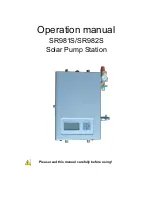
Selwood Seltorque S150 Manual
5
6. Fit the three radial cap screws in accordance with
the instructions at Section 1.5.2.
7. The coupling assembly is now prepared for the
replacement of the pump.
8. Once the pump drive shaft is engaged in the
coupling hub bore, set the position of the coupling
assembly to that previously marked when Section
1.5.1 was performed.
9. Tighten the setscrew that locks the steel hub of
the coupling assembly to the pumps drive shaft
key.
1. All electrical connections should be made through
adequately
rated
conductors
and
starters.
Isolators and other associated switchgear should
be of adequate capacity for the imposed power
loadings. All electrical equipment should be
adequately earthed.
2. Isolate the power supply before carrying out any
commissioning, servicing or maintenance work on
the pump or electric motor.
3. Where electric motors are to be operated in
hazardous or explosive atmospheres they should
be of the flameproof enclosure type appropriate to
that atmosphere.
You are requested to take such steps as are
necessary to ensure that this information is made
available to all those involved with the use of our
products. This information must be made available not
only to your own employees at their workplace, but
also to anyone who may purchase or otherwise
acquire (hire) such products for use in his own
workplace.
It is our intention constantly to review our obligations
under the Act and we will be issuing from time to time
further information with regard to the safe application,
use, inspections, and service associated with our
products.
1.7 Fitting Instructions for Fenner
1. Adjust position of pump on chassis until the inside
faces of the coupling flanges are parallel to each
other. The distance between the faces should
measure from 24 to 29mm (15/16” to 1 1/8”).
Whilst adjusting the pump’s position, it is also
necessary to achieve alignment of the shaft
centre-lines within 1.5mm (1/16”) of each other by
laying a straight edge cross the two flanges at
several positions around their circumferences.
Fully tighten the nuts immediately the coupling
flanges are correctly aligned. Recheck alignment
after tightening.
2. The flexible coupling assembly should now be
completed. Open-out the tyre and fit over the
coupling flanges ensuring the tyre beads seat
properly on the flanges. To ensure proper
seating, it may be necessary to strike the outside
diameter of the tyre with a small mallet. When
seated there should be a gap between the ends of
the tyre of about 1/8” (3mm). Tighten clamping
ring screws in flange alternately and evenly
(approximately half a turn per screw) working
round the flange until 17lbf ft (2.35kgf m) torque is
achieved.
1.8 Seltorque S150 Standard Data
Capacity (max)
400M
3
/h
88,000 UK gal/h
Delivery Head (max)
21.3m
70ft
Self Priming Lift (max)
8.8m H
2
0
29ft H
2
0
Solids Size (max)
100mm
4in
Air Handling Capacity:
Single
24l/s
Prime
50ft
3
/min
Twin
48l/s
Prime
100ft
3
/min
Pump Speed
1600rpm Max
Port Size BS.4504 Table 6
150mm
6in
Lack of routine maintenance is the most frequent
reason for the breakdown of pumps. We earnestly
advise users to ensure that at least the following
actions are taken.
1. Check these three oil levels daily:
a) Engine oil.
b) Bearing housing oil.
c) Flushing chamber oil.
2. Always drain water from the pump in cold weather
when it is not running. Drain:
a) Pump body.
b) Delivery valve chamber.
c) Both sides of air pump (4 drain taps if twin
prime).
3. Do NOT run the pump if significant quantities of
water escape through the exhaust valve of the air
pump. This pump is designed to handle moisture-
laden air, but not to pump a high percentage of
water. Refer to servicing instructions for further
advice.
4. Do NOT run the pump if malfunction is suspected
in any of its parts. In particular, it must
immediately be serviced if the level of oil in the
flushing chamber varies daily, or if the oil becomes
contaminated with the pumped fluid.
5. A hose strainer should always be fitted to the free
end of the suction line if there is a possibility of
oversized solids entering the pump. The
dimensions of rocks, pebbles, etc. must not
exceed 100mm (4"). Larger soft solids, however,
of the type found in abattoir duties, for example,
will pass freely through the pump. Refer to
Selwood Ltd if in need of advice in this connection.
Summary of Contents for SELTORQUE S150
Page 25: ...Selwood Seltorque S150 Manual 25 THIS PAGE INTENTIONALLY BLANK ...
Page 28: ...Selwood Seltorque S150 Manual 28 ...
Page 30: ...Selwood Seltorque S150 Manual 30 ...
Page 32: ...Selwood Seltorque S150 Manual 32 ...
Page 34: ...Selwood Seltorque S150 Manual 34 ...
Page 36: ...Selwood Seltorque S150 Manual 36 ...
Page 38: ...Selwood Seltorque S150 Manual 38 ...
Page 40: ...Selwood Seltorque S150 Manual 40 ...
Page 42: ...Selwood Seltorque S150 Manual 42 ...
Page 44: ...Selwood Seltorque S150 Manual 44 ...
Page 46: ...Selwood Seltorque S150 Manual 46 ...
Page 48: ...Selwood Seltorque S150 Manual 48 ...
Page 50: ...Selwood Seltorque S150 Manual 50 ...
Page 52: ...Selwood Seltorque S150 Manual 52 ...
Page 54: ...Selwood Seltorque S150 Manual 54 ...
Page 56: ...Selwood Seltorque S150 Manual 56 ...
Page 58: ...Selwood Seltorque S150 Manual 58 9 WIRING DIAGRAMS 9 1 Isuzu 4JG1 Engine Canopy ...
Page 60: ...Selwood Seltorque S150 Manual 60 9 3 Deutz Wiring Diagram ...
Page 62: ...Selwood Seltorque S150 Manual 62 THIS PAGE INTENTIONALLY BLANK ...






































